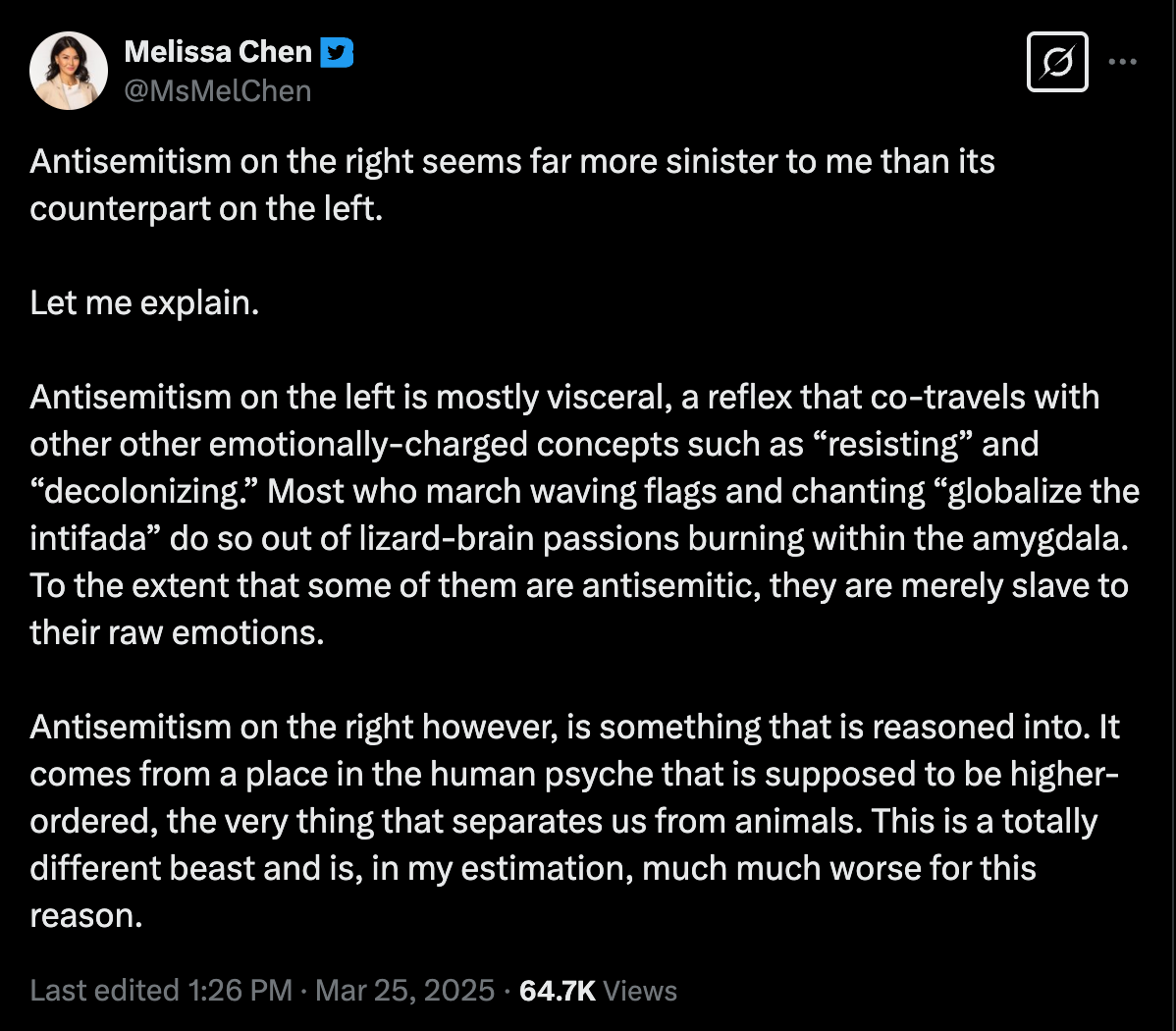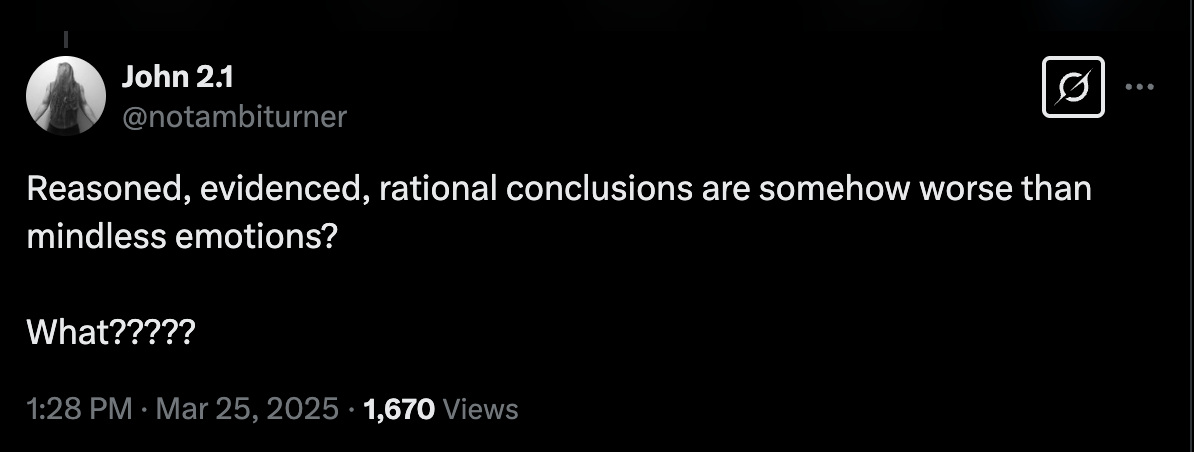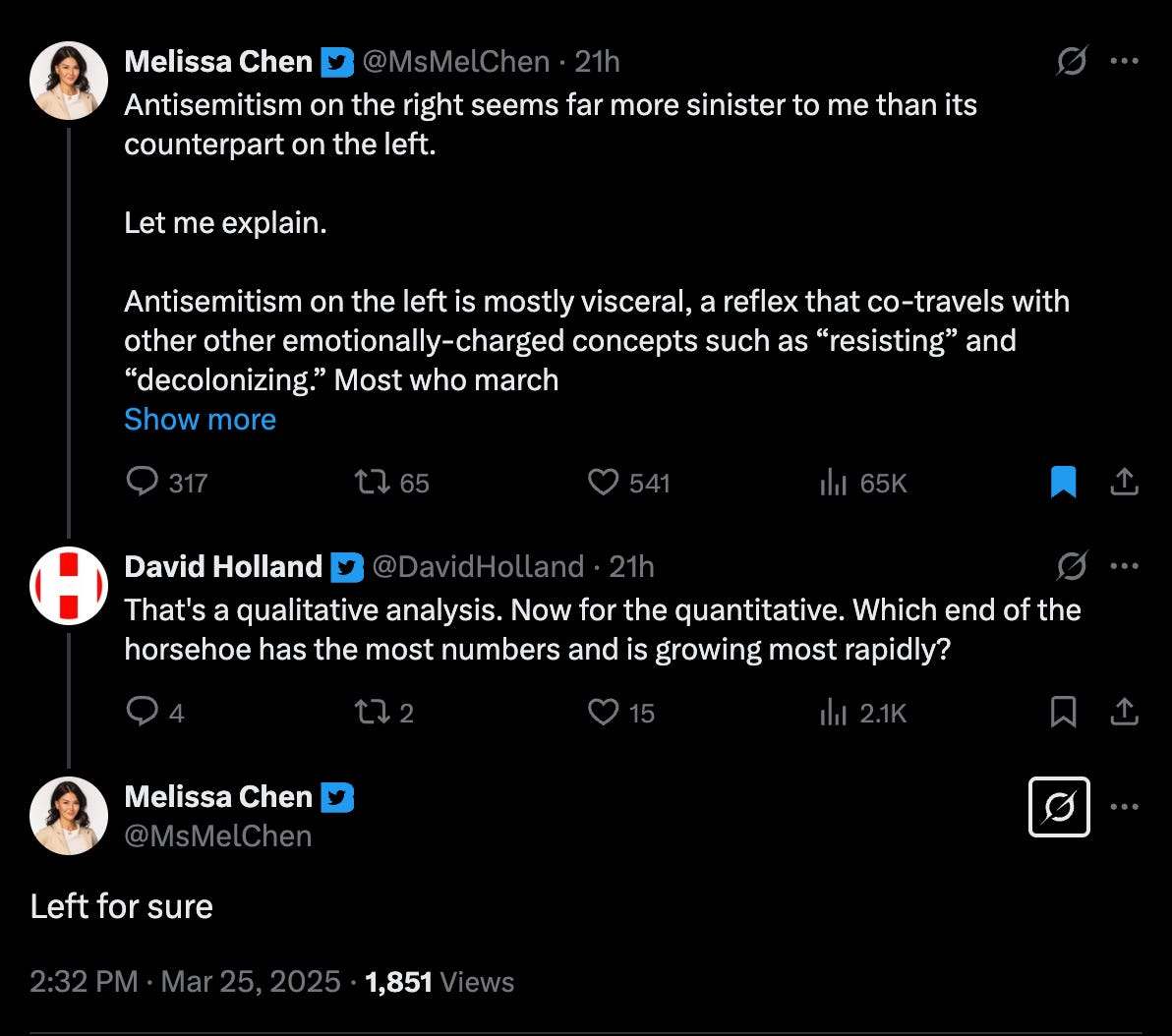
GPT Illustartion
...in Melissa Chen’s X Post
Thanks to my readers' generosity, all my articles are free to access. Independent journalism, however, requires time and investment. If you found value in this article or any others, please consider sharing or even becoming a paid subscriber, who benefits by joining the conversation in the comments. I want you to know that your support is always gratefully received and will never be forgotten. Please buy me a coffee or as many as you wish.
Introduction: Unmasking the Hidden Games in Political Rhetoric
On the battlefield of epistemological warfare, social media posts can distort the truth and drive a wedge between entire communities through the subtle power of language. In her March 25, 2025, X post, Melissa Chen compares antisemitism on the political right and left, claiming the right’s version is “far more sinister” because it’s “reasoned into.” (Full history).
At first glance, her argument seems like a thoughtful critique, but beneath the surface lies a web of neurolinguistic games, bafflegab (intentionally vague, misleading language), and a binary framing promoting schismogenesis — creating social divisions. In this article, I’ll dissect how Chen’s weaponized rhetoric functions as epistemological warfare, using complex equivalences, cause-effect distortions, and polarizing binaries to obscure the truth and divide her audience. More importantly, I’ll demonstrate how to use Robert Dilts’ Sleight of Mouth patterns to reframe her statements, revealing how such tactics can be dismantled to foster logos (λόγος), AKA critical thinking, and prevent the social fractures they aim to create. Read on to see how language can be weaponized—and how to fight back.
Melissa Chen (Photo from X Profile)
Neurolinguistic Games, Bafflegab, Schismogenesis, Loaded Language, and the Redefinition of "Antisemitic" in Chen’s Post
Chen’s post employs several rhetorical tools, including neurolinguistic patterns rooted in NLP (Neuro-Linguistic Programming) concepts like complex equivalence and cause-effect distortions, to frame her argument in a way that obscures clarity and weaponizes epistemology. She also uses loaded language, as defined by psychologist Robert Jay Lifton1, to appeal to emotion and influence her audience beyond the literal meaning of her words. Her reliance on binary false dichotomies sets the stage for schismogenesis, amplifying social divisions. Additionally, the historical redefinition of the term antisemitic — which technically applies to all Semitic peoples, including Palestinians, but has been narrowed to mean anti-Jewish sentiment — adds another layer of bafflegab confusion, further complicating the discourse. Let’s break down the key examples:
Complex Equivalence: “Antisemitism on the right = more sinister because it is reasoned”
Analysis: Chen creates a complex equivalence2, where “reasoned antisemitism” is equated with being “more sinister.” This linguistic distortion assumes that reasoning inherently makes an act more evil without evidence. The term sinister — etymologically meaning “left” but now meaning “evil”3 — adds a layer of irony as she applies it to the right, potentially invoking a subconscious cultural bias against the left to make the right seem more malevolent.
Loaded Language Element: The word sinister is a classic example of loaded language, as described by Lifton4. It carries strong emotional overtones, evoking fear and foreboding beyond its literal meaning, and is designed to sway the reader’s emotions rather than engage their rational judgment. Lifton notes that loaded language “preys on the human weakness for acting immediately based upon an emotional response,” which Chen leverages to make the right’s antisemitism seem inherently more evil.
Redefinition of "Antisemitic" Element: The term antisemitism itself adds to the bafflegab confusion due to its historical redefinition. Originally, “Semite” referred to any people speaking Semitic languages, including Arabs like Palestinians, as well as Jews5. However, since the 19th century, antisemitism has been redefined to specifically mean hostility toward Jews, a shift popularized by Wilhelm Marr in 18796. This redefinition creates an etymological fallacy, as Chen’s discussion of left-wing antisemitism — often tied to anti-Zionist rhetoric like “globalize the intifada” — ignores that Palestinians, who are also Semites, are often the focus of such protests. By not acknowledging this ambiguity, Chen perpetuates a linguistic distortion that obscures the broader context of Semitic identity, further muddying the discourse.
Bafflegab Element: The use of sinister and the unaddressed redefinition of antisemitism contribute to bafflegab because they obscure the truth by hiding the lack of concrete examples, data, or nuance about the term’s broader applicability7.
Cause-Effect Distortion: “Left-wing antisemitism is visceral, therefore less sinister”
Analysis: Chen asserts that antisemitism on the left is driven by “lizard-brain passions burning within the amygdala,” implying a cause-effect relationship: because it’s emotional, it’s less dangerous or calculated. This is a distortion in NLP terms8, as it oversimplifies the harm of emotional biases and ignores how emotions can be weaponized in coordinated movements9.
Loaded Language Element: The phrase “lizard-brain passions burning within the amygdala” is loaded language, as it evokes a visceral, almost primal image of irrationality and animalistic behavior. Lifton highlights that loaded language often comes in pairs with “Boo! and Hooray! versions”10, and here, Chen uses the “Boo!” version to diminish the left’s antisemitism as a mere emotional reflex, contrasting it with the “Hooray!” version of the right’s “higher-ordered” reasoning, which she frames as more sinister. This emotional framing manipulates the reader’s perception, downplaying the left’s role.
Redefinition of "Antisemitic" Element: Chen’s reference to left-wing antisemitism, particularly through the example of “globalize the intifada” chants, is complicated by the redefinition of antisemitism. These chants are often part of pro-Palestinian activism, and Palestinians, as Semitic people11, are technically included in the original meaning of “Semite.” However, the modern usage of antisemitism as anti-Jewish sentiment12 allows Chen to frame such activism as antisemitic without addressing the irony that criticizing Israel — a state often conflated with Jewish identity — may also involve Semitic peoples on the other side. This ambiguity, unaddressed in her post, adds to the bafflegab by conflating anti-Zionism with antisemitism, a point of contention noted in the Rutgers study13, which critiques how such conflation silences pro-Palestinian voices.
Bafflegab Element: By framing left-wing antisemitism as a “reflex” tied to “decolonizing” passions and ignoring the semantic complexity of antisemitism, Chen uses jargon-heavy language to deflect from its scale and impact, a classic bafflegab tactic to “obscure the truth”14. This minimizes the left’s role while amplifying the right’s perceived malice.
Polarization Through Binary Framing: “Right vs. Left Antisemitism”
Analysis: Chen’s entire argument hinges on a binary framing of antisemitism as either “reasoned” (right) or “emotional” (left), ignoring the spectrum of motivations and the overlap between the two (e.g., the “sigma antisemitism” she later mentions with Kanye West). This binary is a form of chunking up in NLP15, where complex phenomena are generalized into oversimplified categories, limiting nuanced understanding. It’s also a false dilemma, as described in the web search result16, because it presents two options as collectively exhaustive, excluding other possibilities like hybrid motivations or non-ideological antisemitism.
Schismogenesis Element: This binary framing introduces the potential for schismogenesis — the formation of social divisions and differentiation17. Anthropologist Gregory Bateson, who coined the term, described schismogenesis as a process where groups define themselves against each other, leading to escalating division. Chen’s “right vs. left” dichotomy encourages her audience to align with one side and oppose the other, fostering a schism between political factions. For example, replies to her post, like Mitchell Gant’s, show this division in action, as he accuses Chen of downplaying the left’s mainstreamed antisemitism, deepening the rift between perspectives.
In a polarized media ecosystem, as noted in the web search result from appliednetsci.springeropen.com18, such binaries can lead to echo chambers, where groups further entrench their views by defining themselves against their “opponents,” a process Bateson warned could cause societies to “break apart” without mechanisms to maintain integration19.
Loaded Language Element: The binary itself is reinforced by loaded language, such as “reasoned” (positive, Hooray!) versus “visceral” (negative, Boo!), which Lifton notes is a common tactic to evoke emotional reactions20. This emotional polarization amplifies the schismogenic effect, as readers are nudged to feel moral superiority or disdain based on their political alignment.
Redefinition of "Antisemitic" Element: The binary framing is further complicated by the redefinition of antisemitism. By focusing on “right vs. left” antisemitism without acknowledging that Palestinians — also Semites—are often central to left-wing critiques of Israel, Chen perpetuates a linguistic distortion. The term antisemitism has been redefined to exclude other Semitic peoples21, which allows Chen to label pro-Palestinian activism as antisemitic without addressing the broader Semitic context. This omission fuels the schismogenic divide by pitting “pro-Jewish” (right) against “pro-Palestinian” (left) perspectives, ignoring the shared Semitic identity that could bridge understanding.
Bafflegab Element: The binary framing, combined with the unaddressed redefinition of antisemitism, is misleading, as it avoids addressing the broader context of antisemitism across ideologies22. This vagueness allows Chen to push a narrative without engaging with the full complexity, a hallmark of bafflegab in political rhetoric.
Appeal to Authority: “Higher-ordered psyche”
Analysis: Chen claims that right-wing antisemitism comes from a “higher-ordered” place in the psyche, “the very thing that separates us from animals.23” This is an appeal to a pseudo-scientific authority (the psyche, neuroscience) to lend credibility to her claim, without defining what “higher-ordered” means or providing evidence. In NLP, this is a presupposition — an unstated assumption that the audience must accept to follow the argument24.
Loaded Language Element: The phrase “higher-ordered psyche” is loaded with a positive connotation, implying superiority and rationality, while “the very thing that separates us from animals” evokes a sense of human exceptionalism. Lifton warns that such language can “prey on the human weakness for acting immediately based upon an emotional response”25, and here, Chen uses it to elevate the right’s antisemitism as more calculated, thus more sinister, without substantiating the claim.
Redefinition of "Antisemitic" Element: The appeal to authority in framing right-wing antisemitism as “higher-ordered” also relies on the redefined meaning of antisemitism as exclusively anti-Jewish. By not acknowledging the broader Semitic context, Chen’s argument implicitly excludes other Semitic groups, like Palestinians, from consideration, reinforcing a narrow definition that aligns with her binary framing and further obscures the complexity of the issue.
Bafflegab Element: The phrase “higher-ordered psyche” is technical jargon that sounds authoritative but is vague and untestable, fitting the definition of bafflegab as “convoluted sentence structures” used to deflect criticism26.
How Bafflegab, Schismogenesis, Loaded Language, and the Redefinition of "Antisemitic" Function as Epistemological Warfare
Chen’s use of bafflegab, binary false dichotomies, loaded language, and the unaddressed redefinition of antisemitism isn’t merely rhetorical flair — it constitutes a form of epistemological warfare designed to influence perceptions of knowledge and truth while actively dividing her audience.
By employing complex equivalences, cause-effect distortions, vague jargon, emotionally charged language, and a redefined term, she:
Obscures Accountability: By framing left-wing antisemitism as a “visceral reflex,” Chen downplays its intentionality and impact, deflecting accountability from left-leaning movements. The loaded language of “lizard-brain passions” minimizes its seriousness by evoking a primal, almost excusable image. The redefinition of antisemitism as exclusively anti-Jewish allows her to label pro-Palestinian activism as antisemitic without addressing the irony that Palestinians are also Semites, further obscuring the accountability of such movements by conflating anti-Zionism with antisemitism27. Conversely, by labeling right-wing antisemitism as “reasoned” and “sinister,” she amplifies its perceived malice without providing specific examples, making it harder to challenge her claim.
Polarizes Discourse and Fosters Schismogenesis: The binary framing of “right vs. left” antisemitism, reinforced by loaded language like “reasoned” versus “visceral,” simplifies a complex issue into a moral dichotomy, encouraging readers to pick a side rather than engage with the broader phenomenon. The redefinition of antisemitism exacerbates this by excluding the shared Semitic identity of Palestinians, framing the debate as “pro-Jewish” (right) versus “pro-Palestinian” (left), which deepens the schismogenic divide. This polarization stifles logos (λόγος AKA critical thinking) — a key goal of bafflegab in political contexts28 — and sets the stage for schismogenesis. As Bateson noted, unchecked schismogenesis can cause societies to “break apart”29. In Chen’s case, her binary framing risks deepening the divide between political factions, as seen in the replies to her post, where users like John 2.1 ( @notambiturner and Mitchell Gant challenge her framing, escalating the conflict.
In a media ecosystem already prone to polarization30, this schismogenic effect amplifies division, making it harder for audiences to find common ground on combating antisemitism.
Manipulates Emotional Responses: Terms like sinister and “lizard-brain passions” are loaded language that evoke emotional reactions (fear, disgust) that bypass rational scrutiny, as Lifton warns31. This aligns with the NLP concept of anchoring—linking a word to an emotional state to influence perception32. The redefinition of antisemitism adds to this manipulation by narrowing the term’s scope to anti-Jewish sentiment, which emotionally charges the debate by excluding other Semitic perspectives, like those of Palestinians, and framing the issue in a way that heightens moral outrage on one side while silencing the other. By triggering emotional responses while fostering schismogenesis, Chen’s rhetoric weaponizes epistemology to distort knowledge and divide her audience.
Reframing with Sleight of Mouth Patterns
Robert Dilts’ Sleight of Mouth (SoM) is a set of 14 persuasion patterns designed to reframe beliefs and challenge limiting assumptions, as outlined in the web search result from sleightofmouth.org33. Below, I’ll apply SoM patterns to reframe Chen’s statements, exposing the distortions and offering alternative perspectives. The goal isn’t to rehabilitate her rhetoric but to highlight how bafflegab, loaded language, the redefinition of antisemitism, and schismogenesis can be dismantled through reframing.
Statement: “Antisemitism on the right seems far more sinister to me than its counterpart on the left.”
SoM Pattern: Reality Strategy (How do you know this is true?)
Reframe: How do you determine that reasoned antisemitism is inherently more sinister? What specific examples or data show that the right’s antisemitism is more calculated or harmful than the left’s? Moreover, given that antisemitism has been redefined to mean anti-Jewish sentiment, excluding other Semites like Palestinians, how does this narrow definition shape your framing of the right’s actions? Without evidence and clarity on the term’s scope, this claim relies on subjective perception, amplified by the loaded term sinister to evoke fear rather than reason.
Purpose: This challenges the lack of evidence behind the complex equivalence, exposing the bafflegab, loaded language, and the redefinition’s vagueness.
SoM Pattern: Counter-Example (Find an exception to the rule)
Reframe: Are there instances where emotional antisemitism has been more harmful than reasoned antisemitism? For example, the emotionally charged “globalize the intifada” chants have led to real-world antisemitic incidents, like the 2023 protest near a library targeting Jewish students34. Doesn’t this suggest emotional antisemitism can be just as sinister, despite the loaded language framing it as less so? And considering Palestinians are also Semites, could some of this activism be mislabeled as antisemitic due to the term’s redefinition?
Purpose: This disrupts the equivalence by showing that emotional antisemitism can also be calculated and harmful, while questioning the redefinition of antisemitism, undermining the binary framing that fosters schismogenesis.
Statement: “Antisemitism on the left is mostly visceral, a reflex that co-travels with other emotionally-charged concepts such as ‘resisting’ and ‘decolonizing.’”
SoM Pattern: Intention (What’s the positive intention behind this belief?)
Reframe: Perhaps the intention behind framing left-wing antisemitism as a “visceral reflex” with loaded language like “lizard-brain passions” is to suggest it’s less intentional and thus less blameworthy. But doesn’t this minimize the responsibility of those who perpetuate it, especially when such reflexes are amplified by organized movements on campuses and streets, as Mitchell Gant pointed out in his reply? And by using the redefined term antisemitism without acknowledging its exclusion of other Semites like Palestinians, aren’t you oversimplifying the motivations behind pro-Palestinian activism?
Purpose: This highlights how the bafflegab, loaded language, and redefinition of antisemitism deflect accountability by focusing on intention rather than impact.
SoM Pattern: Redefine (Change the meaning of a key term)
Reframe: What if we redefine “visceral” not as a lack of intent, but as a deeply ingrained cultural bias that’s been normalized on the left? The mainstreaming of antisemitism on the left, as Chen herself acknowledges in a reply, suggests it’s not just a reflex but a systemic issue.
Isn’t that just as sinister as reasoned antisemitism, despite the loaded language framing it otherwise? And if we redefine antisemitism to include its original broader meaning — encompassing all Semites, including Palestinians — doesn’t that challenge the label applied to pro-Palestinian activism?
Purpose: This redefinition exposes the oversimplification in Chen’s framing, showing how bafflegab, loaded language, and the redefinition of antisemitism obscure the systemic nature of left-wing antisemitism, which contributes to schismogenesis by downplaying one side of the divide.
Statement: “Antisemitism on the right however, is something that is reasoned into. It comes from a place in the human psyche that is supposed to be higher-ordered, the very thing that separates us from animals.”
SoM Pattern: Model of the World (View from a different perspective)
Reframe: From a neurological perspective, reasoning isn’t always “higher-ordered.” The amygdala, which Chen associates with the left’s emotional antisemitism, often interacts with the prefrontal cortex (responsible for reasoning) in decision-making. Couldn’t right-wing antisemitism also be emotionally driven, just masked as reasoning? For example, far-right conspiracy theories about Jews often stem from fear and paranoia, not pure logic, despite the loaded language of “higher-ordered” suggesting otherwise. And given that antisemitism excludes other Semites in its modern usage, does this framing overlook broader dynamics of prejudice against all Semitic peoples?
Purpose: This challenges the presupposition of a “higher-ordered psyche,” exposing the bafflegab, loaded language, and redefinition as rhetorical crutches.
SoM Pattern: Consequence (What might happen as a result of this belief?)
Reframe: If we accept that reasoned antisemitism is more sinister, as reinforced by the loaded term sinister and the redefined scope of antisemitism, might we overlook the harm of emotional antisemitism, which Chen admits is more mainstreamed on the left? This could lead to underestimating the left’s role in perpetuating antisemitism, allowing it to grow unchecked while focusing solely on the right, further deepening the schism between political factions by ignoring the shared Semitic identity that could bridge understanding.
Purpose: This highlights the real-world consequences of Chen’s bafflegab, loaded language, redefinition of antisemitism, and schismogenic framing, showing how it skews focus and exacerbates division in the fight against antisemitism.
Statement: “Most who march waving flags and chanting ‘globalize the intifada’ do so out of lizard-brain passions burning within the amygdala.”
SoM Pattern: Another Outcome (Focus on a different result)
Reframe: Instead of focusing on the emotional drivers of these chants, as framed by the loaded language of “lizard-brain passions,” what if we focus on their outcome? These chants have been linked to antisemitic incidents, like the 2023 protest near a library35, and are often part of organized campaigns. Doesn’t this suggest a level of coordination that goes beyond mere emotional reflexes? And given that Palestinians are Semites, could labeling these chants as antisemitic, under the redefined term, be a mischaracterization that obscures their broader context?
Purpose: This shifts the focus from the emotional cause to the coordinated effect, exposing how Chen’s bafflegab, loaded language, and redefinition of antisemitism minimize the intentionality behind left-wing activism.
SoM Pattern: Hierarchy of Criteria (What’s more important?)
Reframe: Is the emotional origin of these chants, as framed by loaded language, more important than their impact on Jewish communities? If the outcome is fear, harassment, or violence against Jews, does it matter whether it’s driven by the amygdala or the prefrontal cortex? And shouldn’t we also consider the redefinition of antisemitism, which excludes Palestinians as Semites, when evaluating the intent and impact of such chants? Shouldn’t we prioritize the harm caused and the broader Semitic context over the neurological source, especially when such chants contribute to schismogenesis by alienating and dividing communities?
Purpose: This challenges the relevance of Chen’s neurological framing, showing how bafflegab, loaded language, and the redefinition of antisemitism distract from the real issue—harm—by focusing on a less relevant criterion, while also highlighting the divisive impact of her rhetoric.
Conclusion: Bafflegab and Schismogenesis as Epistemological Warfare
Melissa Chen’s post uses neurolinguistic patterns like complex equivalence, cause-effect distortions, and binary framing to create a narrative that appears reasoned but is steeped in bafflegab. By employing vague jargon (“higher-ordered psyche”), oversimplified binaries (right vs. left), and loaded terms (sinister), she obscures the complexity of antisemitism, deflects accountability, and polarizes discourse. More insidiously, her reliance on a false dichotomy introduces the potential for schismogenesis, actively fostering social divisions as a form of epistemological warfare. As Gregory Bateson described, schismogenesis occurs when groups define themselves against each other, leading to escalating division36. Chen’s binary framing of antisemitism as “reasoned” (right) versus “emotional” (left) encourages her audience to take sides, deepening the rift between political factions and making it harder to address antisemitism as a unified issue, in a polarized media ecosystem, where echo chambers already amplify division37, this schismogenic effect is particularly dangerous, as it risks breaking apart the social cohesion needed to combat such a pervasive problem.
The Sleight of Mouth reframing exercise reveals how these distortions can be challenged, not to rehabilitate Chen’s rhetoric but to expose its mechanisms. By questioning her assumptions (Reality Strategy), finding exceptions (Counter-Example), redefining terms (Redefine), and shifting focus (Another Outcome, Hierarchy of Criteria), we can dismantle the bafflegab and mitigate the schismogenic potential of her framing, encouraging a more nuanced understanding of antisemitism across ideologies.
In an era where political rhetoric often relies on such tactics to manipulate knowledge and divide audiences, recognizing and reframing these patterns is crucial for fostering critical thinking, resisting epistemological warfare, and preventing the social fractures that schismogenesis can cause.
1 Robert Jay Lifton, “Loaded Language,” Psynso, accessed March 26, 2025, https://psynso.com/robert-jay-lifton-loaded-language/.
2 “Complex Equivalence,” NLP India, accessed March 26, 2025, https://www.nlpindia.net/complex-equivalence.php.
3 Douglas Harper, “Sinister,” Online Etymology Dictionary, accessed March 26, 2025, https://www.etymonline.com/word/sinister.
4 Lifton, “Loaded Language,” https://psynso.com/robert-jay-lifton-loaded-language/.
5 “Antisemitism,” Encyclopædia Britannica, last modified July 20, 1998, accessed March 26, 2025, https://www.britannica.com/topic/antisemitism.
6 “Antisemitism,” Wikipedia, last modified March 25, 2025, accessed March 26, 2025, https://en.wikipedia.org/wiki/Antisemitism.
7 “Bafflegab,” Political Dictionary, accessed March 26, 2025, https://politicaldictionary.com/words/bafflegab/.
8 “Meta Model: Complex Equivalence,” Mind Tools, accessed March 26, 2025, https://mindtools.co.th/nlp-meta-model-complex-equivalence/.
9 e.g., the “globalize the intifada” chants she references, which have been linked to real-world antisemitic incidents, per Wikipedia, “Antisemitism,” Wikipedia, https://en.wikipedia.org/wiki/Antisemitism.
10 Lifton, “Loaded Language,” https://psynso.com/robert-jay-lifton-loaded-language/.
11 “Antisemitism,” Encyclopædia Britannica, https://www.britannica.com/topic/antisemitism.
12 “Antisemitism,” Wikipedia, https://en.wikipedia.org/wiki/Antisemitism.
13 “Conflating Anti-Zionism with Antisemitism,” Center for the Study of Racism and Resistance, Rutgers University, accessed March 26, 2025, https://csrr.rutgers.edu/conflating-anti-zionism-with-antisemitism/.
14 “Bafflegab,” Political Dictionary, https://politicaldictionary.com/words/bafflegab/.
15 “Meta Model: Complex Equivalence,” Mind Tools, https://mindtools.co.th/nlp-meta-model-complex-equivalence/.
16 “False Dilemma,” Wikipedia, last modified March 20, 2025, accessed March 26, 2025, https://en.wikipedia.org/wiki/False_dilemma.
17 “Schismogenesis,” Wikipedia, last modified February 10, 2025, accessed March 26, 2025, https://en.wikipedia.org/wiki/Schismogenesis.
18 “Polarization in Social Media,” Applied Network Science, SpringerOpen, accessed March 26, 2025, https://appliednetsci.springeropen.com/polarization-social-media.
19 Gregory Bateson, Naven: A Survey of the Problems Suggested by a Composite Picture of the Culture of a New Guinea Tribe Drawn from Three Points of View, 2nd ed. (Stanford, CA: Stanford University Press, 1958), 175, quoted in “Schismogenesis,” Wikipedia, https://en.wikipedia.org/wiki/Schismogenesis.
20 Lifton, “Loaded Language,” https://psynso.com/robert-jay-lifton-loaded-language/.
21 “Antisemitism,” Wikipedia, https://en.wikipedia.org/wiki/Antisemitism.
22 e.g., the convergence of far-left, far-right, and Islamist antisemitism noted in Wikipedia,“Antisemitism,” Wikipedia, https://en.wikipedia.org/wiki/Antisemitism.
23 After checking the history of revisions, Chen added this as an afterthought after receiving some criticism.
24 “Meta Model: Complex Equivalence,” Mind Tools, https://mindtools.co.th/nlp-meta-model-complex-equivalence/.
25 Lifton, “Loaded Language,” https://psynso.com/robert-jay-lifton-loaded-language/.
26 “Bafflegab,” Political Dictionary, https://politicaldictionary.com/words/bafflegab/.
27 “Conflating Anti-Zionism with Antisemitism,” Rutgers University, https://csrr.rutgers.edu/conflating-anti-zionism-with-antisemitism/.
28 “Bafflegab,” Political Dictionary, https://politicaldictionary.com/words/bafflegab/.
29 Bateson, Naven, 175, quoted in “Schismogenesis,” Wikipedia, https://en.wikipedia.org/wiki/Schismogenesis.
30 “Polarization in Social Media,” Applied Network Science, https://appliednetsci.springeropen.com/polarization-social-media.
31 Lifton, “Loaded Language,” https://psynso.com/robert-jay-lifton-loaded-language/.
32 “Meta Model: Complex Equivalence,” Mind Tools, https://mindtools.co.th/nlp-meta-model-complex-equivalence/.
33 Robert Dilts, Sleight of Mouth: The Magic of Conversational Belief Change (Capitola, CA: Meta Publications, 1999), quoted in “Sleight of Mouth Patterns,” Sleight of Mouth, accessed March 26, 2025, https://sleightofmouth.org/sleight-of-mouth-patterns/.
34 “Antisemitism,” Wikipedia, https://en.wikipedia.org/wiki/Antisemitism.
35 “Antisemitism,” Wikipedia, https://en.wikipedia.org/wiki/Antisemitism.
36 Bateson, Naven, 175, quoted in “Schismogenesis,” Wikipedia, https://en.wikipedia.org/wiki/Schismogenesis.
37 “Polarization in Social Media,” Applied Network Science, https://appliednetsci.springeropen.com/polarization-social-media.





